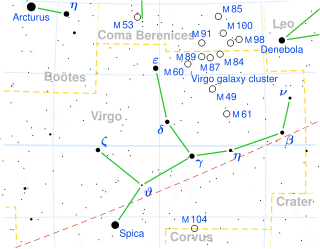Theta Virginis

| |
| Observation data Epoch J2000.0 Equinox J2000.0 | |
|---|---|
| Constellation | Virgo |
| Right ascension | 13h 09m 56.99067s[1] |
| Declination | −05° 32′ 20.4185″[1] |
| Apparent magnitude (V) | 4.37[2] (4.49 + 6.83 + 9.4 + 10.4)[3] |
| Characteristics | |
| Spectral type | A1Vs[4] + ? + A9m + ?[3] |
| U−B color index | +0.00[2] |
| B−V color index | −0.02[2] |
| Astrometry | |
| Radial velocity (Rv) | −2.9[5] km/s |
| Proper motion (μ) | RA: −36.28[1] mas/yr Dec.: −31.22[1] mas/yr |
| Parallax (π) | 10.33 ± 1.09[1] mas |
| Distance | approx. 320 ly (approx. 100 pc) |
| Details | |
| θ Vir Aa | |
| Mass | 3.11±0.11[6] M☉ |
| Luminosity | 190[6] L☉ |
| Surface gravity (log g) | 3.4[4] cgs |
| Temperature | 9,250[4] K |
| Rotational velocity (v sin i) | 4±1[4] km/s |
| Other designations | |
Theta Virginis (θ Vir, θ Virginis) is a multiple star system system in the zodiac constellation of Virgo. Based upon parallax measurements, it is located approximately 320 light years from the Sun. The four[3] stars in this system have a combined apparent visual magnitude of 4.37,[2] which is bright enough to be seen with the naked eye.
The primary component, Theta Virginis Aa, is a white-hued A-type main sequence star with a stellar classification of A1Vs.[4] It is part of a spectroscopic binary[8] whose components, Aa and Ab, have visual magnitudes of +4.49 and +6.83 respectively. The system has an orbital period of about 33.04 years with an eccentricity of 0.9.[3] The brighter member of this pair shows photometric and radial velocity periodicities with a cycle time of 0.7 days, which may indicate its rotation period.[9]
The inner pair is orbited by the 9.4 magnitude B component, which lies at an angular separation of 7.1 arcseconds. A fourth component C is 69.6 arcseconds away and has an apparent magnitude of 10.4.[3]
References
- 1 2 3 4 5 van Leeuwen, F. (2007), "Validation of the new Hipparcos reduction", Astronomy and Astrophysics, 474 (2): 653–664, arXiv:0708.1752
 , Bibcode:2007A&A...474..653V, doi:10.1051/0004-6361:20078357.
, Bibcode:2007A&A...474..653V, doi:10.1051/0004-6361:20078357. - 1 2 3 4 Mermilliod, J.-C. (1986), "Compilation of Eggen's UBV data, transformed to UBV (unpublished)", Catalogue of Eggen's UBV data, SIMBAD, Bibcode:1986EgUBV........0M.
- 1 2 3 4 5 Eggleton, P. P.; Tokovinin, A. A. (September 2008), "A catalogue of multiplicity among bright stellar systems", Monthly Notices of the Royal Astronomical Society, 389 (2): 869–879, arXiv:0806.2878
 , Bibcode:2008MNRAS.389..869E, doi:10.1111/j.1365-2966.2008.13596.x.
, Bibcode:2008MNRAS.389..869E, doi:10.1111/j.1365-2966.2008.13596.x. - 1 2 3 4 5 Landstreet, J. D.; et al. (September 2009), "Atmospheric velocity fields in tepid main sequence stars", Astronomy and Astrophysics, 503 (3): 973−984, arXiv:0906.3824
 , Bibcode:2009A&A...503..973L, doi:10.1051/0004-6361/200912083.
, Bibcode:2009A&A...503..973L, doi:10.1051/0004-6361/200912083. - ↑ Wilson, R. E. (1953), General Catalogue of Stellar Radial Velocities, Carnegie Institute of Washington, D.C., Bibcode:1953GCRV..C......0W.
- 1 2 Zorec, J.; Royer, F. (January 2012), "Rotational velocities of A-type stars. IV. Evolution of rotational velocities", Astronomy & Astrophysics, 537: A120, arXiv:1201.2052
 , Bibcode:2012A&A...537A.120Z, doi:10.1051/0004-6361/201117691.
, Bibcode:2012A&A...537A.120Z, doi:10.1051/0004-6361/201117691. - ↑ "tet Vir -- Star", SIMBAD Astronomical Database, Centre de Données astronomiques de Strasbourg, retrieved 2016-09-05.
- ↑ Adelman, Saul J. (November 1997), "On the possible variability of the main sequence A stars theta Virginis and 109 Virginis", Astronomy & Astrophysics Supplement series, 125, November I 1997, 497-499. (A&AS Homepage), Bibcode:1997A&AS..125..497A, doi:10.1051/aas:1997105.
- ↑ Scholz, G.; et al. (September 1998), "Spectroscopic and photometric investigations of MAIA candidate stars", Astronomy and Astrophysics, 337: 447−459, Bibcode:1998A&A...337..447S.
External links
- Kaler, James B., "Theta Virginis", Stars, University of Illinois, retrieved 2016-09-08.
- Plotner, Tammy; Vogt, Ken (2009), The Night Sky Companion: A Yearly Guide to Sky-Watching 2009, The Patrick Moore Practical Astronomy Series, Springer Science & Business Media, p. 172, ISBN 038779509X.